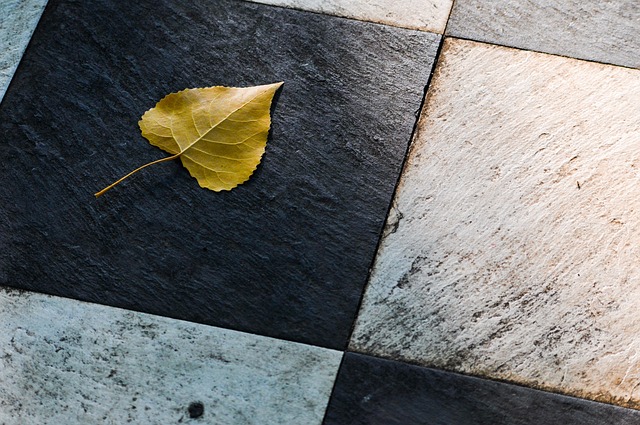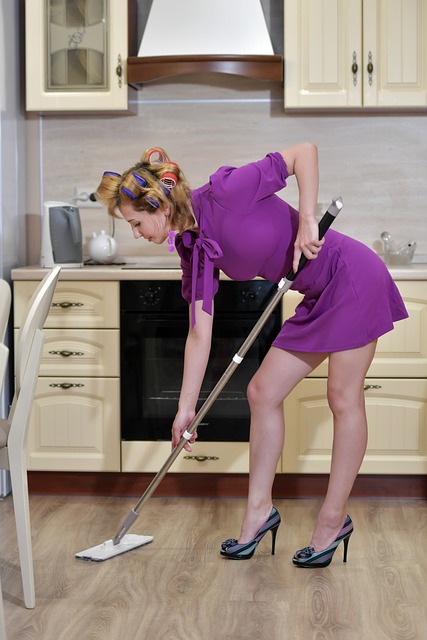Understanding tile floor types is crucial for effective cleaning. Porous stones like marble need gentle yet thorough care, while non-porous tiles such as ceramics are easier to maintain. The best methods involve regular mopping with pH-neutral cleaners, spot treating stains, and sealing grout lines. Tools include a vacuum/broom, mop, tile cleaner, microfiber cloths, floor scrapers, and a bucket of clean water. Preparation involves clearing loose items, sweeping/vacuuming, and protecting baseboards in high-traffic areas. Daily routine includes sweeping, vacuuming with a microfiber mop, and using pH-neutral cleaners. Prompt stain treatment, strategic cleaning solutions, and regular maintenance extend tile floor life and maintain aesthetics in both residential and commercial spaces.
Keeping your home or office tile floors sparkling involves understanding the best methods for cleaning tile floors tailored to specific types. From ceramic and porcelain to natural stone, each requires unique care. Gather the right tools, products, and prepare your space for optimal cleaning. Implement daily maintenance routines and deep clean grout and tiles regularly. Learn to handle stains and tough discolorations, and discover tips for long-term preservation. Discover the best methods for cleaning tile floors and watch your spaces shine.
Understanding Your Tile Floor Types

Understanding your tile floor types is crucial when it comes to implementing the best methods for cleaning them effectively. Different tiles, from ceramic to porcelain and natural stone, have unique characteristics that require specific care. For instance, porous stones like marble need gentle yet thorough cleaning to prevent water damage and staining. Non-porous tiles such as ceramics are generally easier to maintain as they repel dirt and moisture.
Knowing the composition of your floors will help you choose the right cleaning agents and tools. The best methods for cleaning tile floors involve a combination of regular mopping with a pH-neutral cleaner, spot treating stubborn stains with specialized solutions, and sealing the grout lines regularly to inhibit dirt buildup. Regular maintenance and understanding your tile floor types are key to keeping them looking pristine in both homes and offices.
Gather the Right Cleaning Tools and Products

When it comes to cleaning tile floors, having the right tools and products is essential for achieving optimal results. Start by gathering a few key items like a vacuum or broom with a hard brush attachment, a mop suitable for tiles (preferably with a removable head), tile-specific cleaning solutions, and microfiber cloths. Opting for the best methods for cleaning tile floors means investing in high-quality tools that are designed to tackle stubborn stains and grime without damaging your surfaces.
Don’t forget about accessories like floor scrapers for removing hard-to-reach gunk and a bucket with clean water. Using the right equipment ensures efficient cleaning, making it easier to maintain the hygiene and aesthetics of both residential and commercial tile floors. Remember, using inappropriate tools or products can lead to scratched surfaces or ineffective cleaning, so always choose items tailored to tile flooring.
Preparing Your Space for Optimal Cleaning

Before diving into the best methods for cleaning tile floors, preparing your space is key to achieving optimal results. Start by clearing the floor area of any loose items, furniture, or debris. This allows for unobstructed access and ensures a thorough cleaning. Additionally, sweep or vacuum the floor to remove dirt, dust, and grit that might have accumulated.
For offices or high-traffic areas in your home, consider elevating furniture legs on pads or blocks to prevent water damage and allow for deeper cleaning. Protecting baseboards and door jambs with plastic covers will also keep these areas clean during the scrubbing process. By taking these initial steps, you set the stage for efficient tile floor cleaning using the best methods available.
Effective Daily Maintenance Routines

Maintaining tile floors is a crucial part of keeping any space looking its best. Implementing effective daily maintenance routines is one of the best methods for cleaning tile floors and preventing significant buildup or damage. Start by sweeping or vacuuming your floors regularly to remove loose dirt, dust, and debris. This simple step significantly reduces the amount of grime that can later harden into difficult-to-remove stains or attract dirt.
Additionally, using a microfiber mop or a floor scrubber with a suitable cleaning solution designed for tile floors will help you maintain a spotless surface. Avoid using harsh chemicals unless absolutely necessary, as they can strip away the protective coatings on your tiles and grout. Instead, opt for pH-neutral cleaners that are effective yet gentle on the material. Regularly mopping and deep cleaning according to these best methods for cleaning tile floors ensures your floors remain in top condition, enhancing both their aesthetic appeal and longevity.
Deep Cleaning Strategies for Grout and Tiles
Deep cleaning strategies for grout and tiles are essential components of maintaining a pristine tile floor. Beyond regular mopping, specialized techniques are required to effectively remove stubborn stains, grime, and mineral deposits that can accumulate in the crevices between tiles and along grouting. One of the best methods for cleaning tile floors involves using a combination of powerful cleaners, scrub brushes, and steam extraction machines. These tools help dislodge and eliminate deep-seated dirt and debris without causing damage to the tile or grout.
For particularly challenging stains, pretreating with an enzyme-based cleaner can be highly effective. Enzymes naturally break down organic compounds, making it easier for cleaning solutions to penetrate and lift away stains. Additionally, regular maintenance, such as wiping up spills promptly and using mats at entryways, can significantly reduce the buildup of dirt and grime, extending the life and aesthetic appeal of tile floors in both homes and offices.
Handling Stains and Tough Discolorations

When it comes to tile floor cleaning, handling stains and tough discolorations requires a strategic approach using the best methods for cleaning tile floors. The key is to act promptly. As soon as you notice a stain or discoloration, start cleaning to prevent it from setting in deeper. Begin by identifying the type of stain—whether it’s from grease, dirt, mold, or another source—as this will determine your chosen cleaner and technique.
For everyday stains, a combination of warm water, mild detergent, and a soft-bristled brush can be effective. For tougher cases, especially discolorations caused by years of neglect, you might need a commercial tile floor cleaner designed to break down and remove stubborn residue. Always test any cleaning solution in a small, discreet area first to ensure it doesn’t damage or discolor the tiles. Regular maintenance, including sweeping and mopping, along with these best methods for cleaning tile floors, will keep your tile floors looking their best.
Tips for Maintaining a Sparkling Tile Floor Long-term

Maintaining a sparkling tile floor in both homes and offices is an ongoing process, but with the right best methods for cleaning tile floors, it can be easily achieved. Regular vacuuming or sweeping is the first step to keep your tiles clear of dirt and debris. This should be followed by a deep clean using a gentle cleaner suitable for your tile type, avoiding harsh chemicals that could damage the surface.
To ensure long-term cleanliness, consider sealing your tiles, especially in high-traffic areas. This creates a protective barrier, repelling stains and making future cleaning sessions simpler. Additionally, quick action is crucial when dealing with spills; absorb liquids immediately to prevent them from settling into the pores of the tile, causing staining. Regularly testing and rotating cleaning solutions can also help maintain your tiles’ luster over time.
